Archive for Community Service
4 Basic Principles of Garden Design
To get the most out of your garden design, you need to know some basic principles of landscaping. By paying attention to the principles, you’ll increase your creativity and generate new ideas for a unique effect. The best thing is that these guidelines are neither fussy nor constraining. If you have an eye for detail, you’ll quickly end up with a more successful and eye-catching California garden design.
1. Generous Use of Color
Color brings the dimension of life to your garden design. Warm colors like red, orange, and yellow tend to bring objects closer to you. Cool colors like blues and greens are effective in moving things away from you.
A balanced combination of both warm and cool colors can help create perspective in your design. They work well for both plants and hardscape to bring out a particular mood. In garden design, weave colors intricately throughout the design composition for a more balanced look. Remember to extend the presence of color across the seasons at various levels.
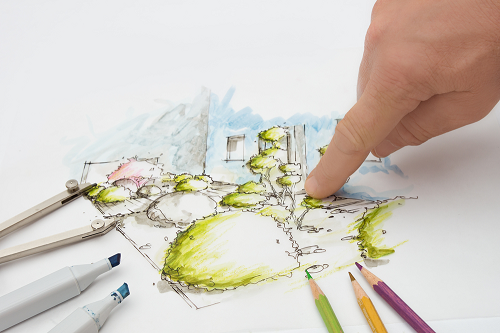
2. Lines are Important in Garden Design
The concept of regulating lines is essential in garden design. An architecture element, like a building edge or door, can create an imaginary line to help connect and organize your layout. They are essential in helping you control movement, accentuate an object, or draw attention to a focal point.
For example, a garden path or walkway leading to an area of interest will naturally direct a person to that object. On the contrary, a meandering walkway will create a feeling of uncertainty or surprise.
Lines can be vertical, diagonal, curved, or straight and may either be real or implied. The latter is created from a series of objects aligned in a way that makes them look like they are in a line. This effect is common in designs that use plant forms to imply a line. The use of lines to regulate the garden design spells the difference between professional and amateur design.
3. Bring Out Texture in Your Design
In gardening, the use of texture is common to achieve a fantastic curb appeal. Texture falls into three different categories, namely, fine, medium, and coarse. For example, the texture of pavements differs from that of plants and other elements. Contrasting textures can add an exciting feature to design composition.
The texture of plants in gardening refers to the overall presence of the plants. In general, plants have two texture types, namely, bold and soft. Bold textures tend to attract more attention. They are those plants that reach great heights and come with large, impressive foliage.
Plants with soft textures have a less visual impact as they have small and delicate foliage. They may not make a statement in the garden immediately, but they effectively offer a whimsical appearance, serving as a vital aspect of the garden.
4. Unity in Your Overall Design
The three principles above are not complete without unity. In this case, unity refers to the repetition, balance, harmony, and consistency of a design. Consider repeating elements like plants, color, and decor in the landscape. Consistency is crucial as it helps you achieve unity by bringing together different landscaping elements to create a common theme.
Don’t forget to balance your design, either symmetrically or asymmetrically. In symmetrical balance, two sides of your design look similar, while asymmetrical balance is more about using different objects and elements to achieve balance. They, however, must have almost identical imaginary weight, size, and shape.
Final Thoughts
With these four principles of garden design, you can creatively unleash your landscaping prowess. Utilizing color combinations, lines, and textures, you will end up with a unified design of your landscape. If you need professional help in your garden design venture, reach out to us for expert guidance.
Tips To Keep Your Bushes Looking Their Best All Year
We can all agree that bushes are an essential part of any lawn. They make a great attraction and addition to places like walkways and fountains. You can also use them as the background of your lawn’s garden beds.
But for these small to medium-sized woody plants to keep looking their best all year, you need to take great care of them. The goal here is to ensure they add structure, texture and beauty to your landscape.
If you already have bushes or plan to plant them in your loan, there’s something here for you. We’ll cover the maintenance tips needed to keep the woody plants strong and healthy.
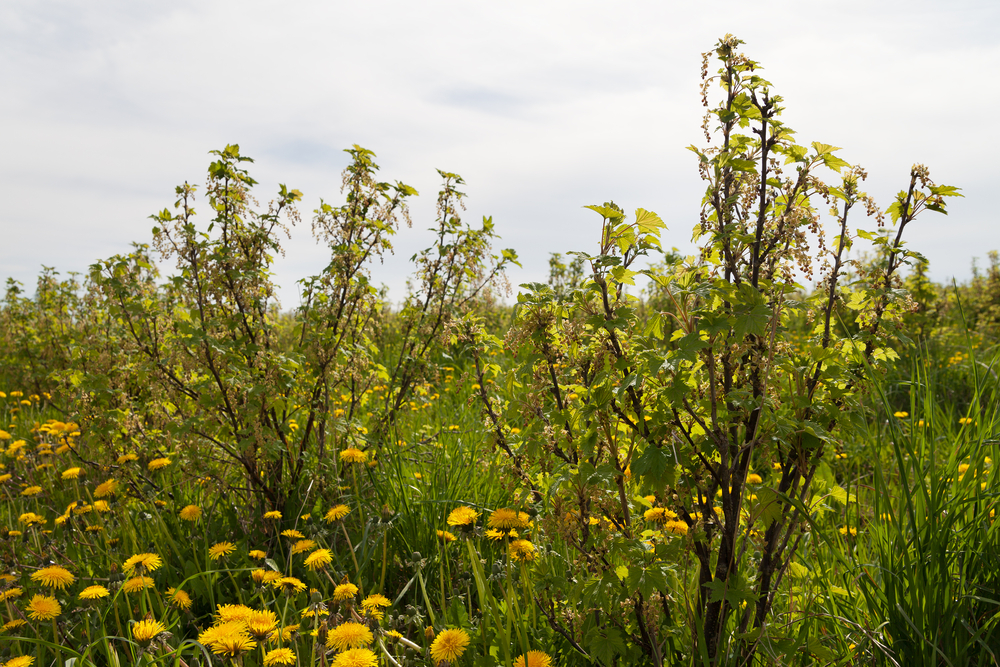
- Plant the Bushes at the Right Time
The lawn plants you choose to plant must be adaptable to your area’s climatic conditions and soil. Check the package for instructions and labels on the right growing conditions.
Fall is the best time to introduce new plants to your lawn. This allows the plant to get more time to adjust and grow before winter arrives. Also, during fall, the plant’s root system can easily establish before spring.
- Set a Watering Schedule
Your lawn plants will definitely need water to thrive and survive. You should therefore schedule watering at least once a week and do it thoroughly.
If watering the plants with a sprinkler, set the timer at least 10 minutes. Stop watering when the soil absorbs the water completely or when the lawn is soaked in water.
Water your new plants at planting time and intervals of 1 to 2 weeks daily after planting. You should also water them every 2 to 3 days once 3 to 12 weeks pass after planting. The plants will have more established roots after 12 weeks.
- Stick to Proper Feeding Habits
Instead of feeding your newly-planted bushes with fertilizers, mulch the soil with adequate compost. Mulching helps enrich the soil with essential micronutrients.
Later on, you can add fertilizers based on the nutrition requirements of the plants. For fragile plants, a layer of compost can help amplify the soil nutrients.
The most commonly used nutrients for the plants are potassium, phosphorus and nitrogen. Other essential nutrients include fairly large quantities of sulfur, magnesium and calcium.
- Prune at the Right Times
Pruning can only help maintain the shape and size of the plants if done regularly. You also need to employ different pruning tools for the task.
The best time for pruning the plants has to be spring. However, you have to figure out when the plant blooms. If its blooming season is spring, prune it when flowering stops.
And if it blooms in summer, consider trimming it in early spring or late winter before new growth forms. Either way, light summer pruning will work with a deciduous plant, while heavier pruning (in late winter) will be ideal for a dormant plant.
- Tie or Stalk the branches
Stalking the new bushes will work if they appear weak and it becomes difficult to straighten them. Give the plants some support until they develop a strong trunk. While doing this, ensure that the stalk has the same height as the plant.
You can also tie the stalk to the branches using heavy wrapped wire. But the cable needs to be shielded with a hose to protect the plant’s bark from grinding.
- Test the Soil
Soil testing will help you find out if the land has any deficiencies. If the test results suggest that there are deficiencies, address them using appropriate fertilizer. For instance, slow-release fertilizers will help you overcome nitrogen deficiency.
You can have your soil tested expertly if you send a sample to a soil lab in your area. Locally purchased soil test kits can also help you do this task.
- Watch out for Pests
Pests are undeniably a cause of concern in the maintenance of lawn plants. A lawn care professional can advise you on a suitable method to counter pest infestation on your lawn.
Examples of the most damaging lawn pests include Japanese beetles, masked chafers and white grubs. Others include caterpillars, mites and aphids.
- Mulching the Soil to Retain Moisture
Mulching is a great way to retain the warmth and moisture of the soil. The mulch can help your bushes take water from the soil during winter. It can be in the form of tree bark and wood chips if you lean more on the organic side and plastic paper for the inorganic options.
You can apply the mulches to the soil surface around your plants. This helps reduce soil erosion and control weeds. It also helps maximize the growth of your new bushes while cutting fertilizer costs.
The Takeaway
Implementing proper bush maintenance and gardening is the best way to keep your bushes and lawn looking healthy all year round. Good luck trying out these practices on your lawn.
And if you need professional lawn and landscaping help, we are always here to help you. Reach out today for a free estimate.
Hire a Xeriscape Santa Rosa Expert When Facing Landscaping Problems
Some property owners have let their lawns go despite the intense focus on exceptional property exteriors and interiors. Though you might assume that the yard contributes little to your property, remember that people will base their opinion on what to expect in your interiors on what they see in your outdoors. Drab and messy lawns only paint your home or commercial premises in poor light.
You only get one chance for the best first impression, so you must make it count by hiring an expert to make your lawn. Some property owners think they have what it takes to plant and maintain exceptional landscapes. To them, a xeriscape Santa Rosa expert is unnecessary, even when in dry locations. Nonetheless, handling lawn care as a DIY project often leads to mistakes highlighted below.
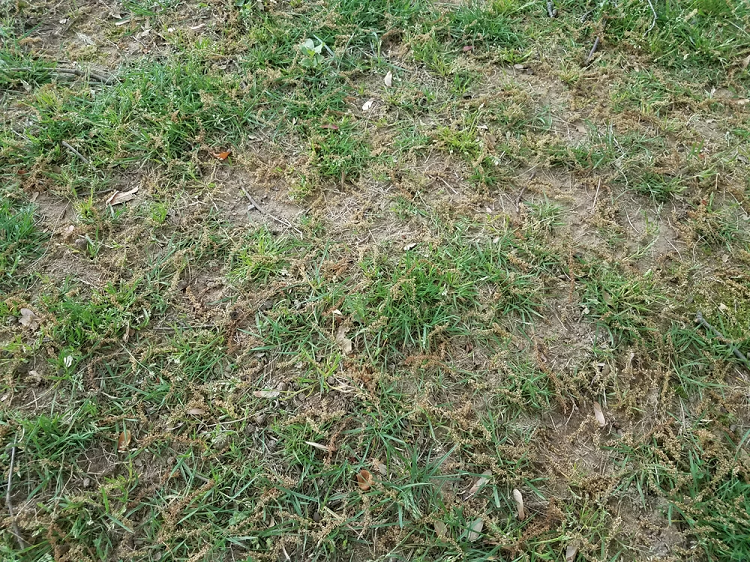
Too much shade
Shade is essential when putting together the perfect landscape. It protects plants affected by excessive sunlight and introduces some interesting height variations in your outdoor. Nonetheless, large trees and structures can lead to excess shade. An expert can help you choose the ideal trees to plant on your lawn for just the right amount of shade or raise the canopy of your trees.
Voles and moles, among other critters
It is easy to pick mole damage on your lawn. This critter creates tunnels under the soil, thus pushing the ground and creating unsightly ridges on your property. Raccoons and skunks can also invade your yard to dig for food. You need a lawn care company well-versed in ways of humanely getting rid of the critters on your lawn. Moreover, the experts will institute measures to protect your lawn from invasion by the common pests in your area.
Patchy grass
With this issue, you will notice that the grass in your outdoors grows at different lengths, strengths, and colors. The leading cause of a patchy lawn is spot seeding or reseeding with a different grass seed species from what you have used on the rest of your yard. It can also follow the wrong choice of a grass seed species for your soil or climate. Consulting a lawn care professional on the grass seed recommendation for your lawn will prevent patchy grass. For example, when reseeding northern lawns, it is best to use Kentucky bluegrass or perennial ryegrass, while tall fescue, Bermuda grass, or centipede grass work best for southern lawns.
Overwatering
Some property owners, especially those in dry areas and sandy soils, assume that watering their plants is the only way to ensure their lawns thrive. Though watering is essential, most DIY landscapers end up overwatering their lawns. Even in soils that retain water, plants have different water needs. When you overwater a lawn, you will usually notice mushrooms growing and the discoloration or yellowing of grass. Lawn care experts well versed in xeriscape Santa Rosa techniques will suggest alternative ways of ensuring your plants have enough moisture even in dry climates. They will also help you pick the right irrigation system for your space and use the right water amount to keep your plants thriving.
Compacted soil
The soil on your lawn is a living, breathing component. Its compaction following heavy equipment use and repeated mowing patterns shrinks the pores that promote the aeration of your soil, thus squeezing the life out of your lawn. Some of the signs of compacted soil are discolored, limp, dull, or thinning grass and pooling water. An expert will often regularly change your mowing patterns and aerate your lawn in the fall to ensure your plant roots have enough room for growth.
Turf diseases
If you notice a lesion on your leaf blades, patches, and a smutty substance on your lawn, these might be signs of lawn diseases. Some diseases like dollar spot and ascochyta are generally cosmetic, but others like necrotic ring spot can be deadly. There are several fungicides available for treating lawn diseases, but some can be deadly and worsen the condition. Hire a professional to evaluate the diseases affecting your lawn, recommend the right treatment for it and monitor your turf’s response to medication.
DIY lawn care is often an attempt at saving costs or putting everything you know about plants to the test. Though these are valid reasons, the above issues will cost you more money to manage than hiring a lawn care specialist well-versed in xeriscape Santa Rosa and other techniques of optimal lawn care.
For commercial properties, professional lawn care saves you on the dollars lost when some clients make a poor first impression of your business and opt for your competitors. Thankfully, professional lawn care is quite affordable and thus within everyone’s budget. Contact us today for the best-looking outdoor space.
Small Backyard Ideas for a Magical Outdoor Space
Well-designed outdoor spaces can increase your enjoyment of your home. But what if you have a small backyard? Well, the good news is you don’t need a sprawling estate to transform your backyard into an outdoor oasis. Thoughtful landscape design can transform your small patio or yard into a refreshing outdoor space.
Transform Your Home with these Small Backyard Ideas
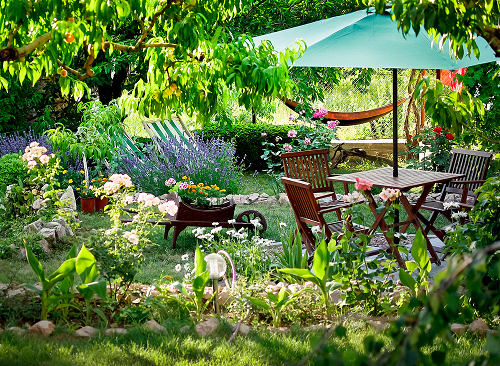
Whether you live in an apartment, townhouse loft, or a house with minimal outdoor space, you can carve out an outdoor space for yourself. Yes, even modest balconies and rooftop terraces count. Even a small yard can feel grand if you design it the right way.
Here are some small backyard ideas that can help you maximize the little space you have.
1. Create a Container Garden
You may not have the space or time to become a master gardener, but you can learn to create striking container gardens. When you lack good soil, containers allow you to make the ideal conditions for your plants to thrive.
All you need is a planter, some potting soil, and the plants of your choice. From hanging baskets to window boxes, you can embellish your backyard with bold foliage for a refreshing space your friends and family will love.
2. Think About Vertical Space
Vertical gardens, or living walls, are ideal features for small spaces. Think of the magnificent living tapestries that ornament public gardens and some buildings. You can bring the same beauty and vitality into your home using vine-covered trellises, closely planted fruit trees, and decorating your walls with hanging plants.
Reinvigorating your exterior with a living wall brings your backyard to life, attracting songbirds and pollinators, and can help temper the summer heat. Living walls also act as art, establish boundaries within a landscape, give you a sense of privacy, and obscure undesirable views.
3. Create a Focal Point
Focal points are used in landscape design to draw and direct the eye. If your backyard consists of a swath of plants or is crammed with furniture, your eyes will sweep along the area, not knowing where to land.
If your backyard is filled with plants and feels more like a garden, you can use a statue or a small fountain to detract some attention from the plants. You can also strategically place furniture to draw in the eyes. Conversely, if your space is adorned with furniture, you can use a large plant as a focal point.
4. Use Every Inch – Even the Side Yard
The side yard is often overlooked and can easily become a sad spot adorned with nothing but unsightly air-conditioning units. You can perk up your side yard by adding a stepping-stone path or install a welcoming entry gate if your space allows.
Another way is to draw the eyes up, away from the sides, using arbors, hanging vines, or strategic overhead lighting.
5. Embrace a Multi-Level Landscape Design
Breaking up your yard with steps, decks, retaining walls, or terraces can create the illusion of a larger backyard. A multi-level design helps to break things up visually, and you can help you separate the different functionalities of your yard.
You can have a dining patio on the upper level and incorporate different greenery into the lower levels.
6. Create a No-fuss Patio or Deck
Don’t have a green thumb? Not to worry. You can set up a murphy bar or an al fresco dining room on a bed of gravel, and voila! You added a little polish to your backyard. Add some statement chairs to create a laid-back or rustic atmosphere depending on the vibe you’re going for. And don’t forget to add some hanging lights to elevate the mood at night.
The idea here is to create a warm, welcoming space that doesn’t require you to get your hands dirty.
7. A Small Kitchen and Dining Area
Love to grill? You don’t necessarily need a large space for this. You can create an outdoor cooking center. All you need is a little space for a basic grill, counter, and a small dining area. You can even add to the ambiance by adding a fireplace or a small garden.
For your family, this could mean growing herbs in the garden, cooking dinner outdoors on the weekends, and enjoying evenings by the fire.
8. Maximize on Available Space
When you have a small backyard, it’s best to create a multifunctional space. You can invest in some portable furniture that you can keep in your basement or garage when not in use. Or, you can create seating benches that also double as storage spaces for lawn games and plants.
Better yet, you can build a mini storage shed that’s cute yet functional.
Revitalize Your Backyard
Looking for small backyard ideas that make a statement? DK Landscaping can help you create the backyard of your dreams. We are a full-service maintenance company with the tools and expertise to help you create a flourishing landscape.
Contact us today! The solution to your lawn and garden woes lies with us.
Landscape Maintenance for Corporations
Landscape maintenance is a manicuring activity that is carried out at intervals on lawns and gardens to sustain or improve their physical outlook. This activity can be done weekly or fortnightly, depending on the negotiation between the property holder and the landscaping company. Corporations have an extensive yard area; hence, it will be most appropriate for them to opt for the weekly package. Professional landscaping companies usually have a catalog of services which they render to their client. Generally, several people believe that landscaping is only a term for trimming, but this is not the case. It extends beyond the trimming because it also incorporates many other processes like composting, pruning, watering, removing leaves, weeding, applying fertilizers, and removing snow.

You need to regularly divert your leisure time to cleaning and trimming your lawn area so that it can look good. This event happens when you are doing it by yourself, but when institutions and corporations want a perfectly groomed lawn, they need to engage professional landscape contractors. These contractors usually map out a maintenance plan, tools to be used, grooming methods, the right plants, irrigation system, and trimming design. You need to understand that landscapers choose these factors based on the climatic season. Company directors can clean their lawns during winter by removing the snow that has piled up in the office yard.
It is essential to hire a seasoned landscape contractor because the activity requires a bit of technicality. Veteran landscapers know what to do on a particular business site. For instance, they take note of the lawn area, the topography, the type of soil, and the elements that need to supplement the beauty of the garden. Similarly, they harness effective gardening methods such as soil aeration. Aeration enables water to drain into the deep parts of the soil, allows fertilizers to mix with the loosened soil, and circulates air for the swift growth of nursery plants.
Skilled landscapers embrace the ideal irrigation technique that facilitates water seepage into the roots of plants. Drip irrigation is the most suitable watering system because it allows water to seep through the soil, and it prevents the wastage of water. The right professionals also have a cognizance of the right kind of plants and the ideal gardening method to be used for any topography.
Businesses that adopt periodic maintenance of their lawns and courtyard tend to attract more clients because anyone that visits such business locations will fall in love with the landscape view. It is a subtle marketing strategy because it can eventually convert one-time visitors into real buyers and long-term clients. When the administrator of the company’s property gets in touch with an adept landscape contractor, both parties will have to agree on certain formalities and sign a legal contract that spans through the lawn maintenance period. Contact us for more information.
Learn How To Create The Perfect Xeriscape
When people say xeriscape they are referring to the practice of designing landscapes using slow-growing, drought-tolerant plants that aim to promote water conservation and reduce the need for regular maintenance.
Although recent drought conditions have created an urgency to adjust to different landscape practices like xeriscaping, many people still opt for xeriscape designs because they look amazing when finally complete.
Having said that, it’s important to remember that designing a xeriscape is not just throwing certain plants into some dirt and expecting them to look spectacular, it’s a process.
So, to help people to get a better grasp of things, we’d like to share some fundamental aspects on the best way to create the perfect xeriscape!
Accurate Designing Will Determine the Final Look
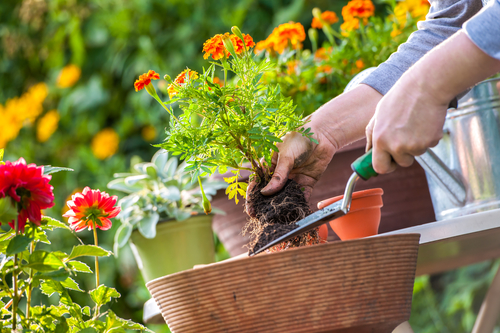
Now, to be as straightforward as possible, it’s important that people know that having plant material in the right place, is one of the most important aspects of xeriscaping.
Whether it be that you’re giving a facelift to an old landscape or designing a new one altogether, a proper design is vital – especially if you intend to conserve resources and achieve an amazing result.
Tips That Help With Xeriscape Design
- Assess the area for the presence of vegetation as this is an indication of whether plant material will grow well in that particular area.
- Arrange your xeriscape into of three different zones; a high water-use zone, a moderate water-use zone, and a low water-use zone. The high water-use zone should be very small, highly visible and watered as needed.The moderate water-use zone is usually a bit larger than the high water-use zone and is only watered when required. Now, the low water-use zone should be at least 60% of the area and only include plant types that are initially watered.
Using these straightforward tips you will be well on your way to creating a xeriscape design that’s efficient, practical, and easily maintained.
Soil Management And Soil Quality Is Important
Managing soil may probably be the part of xeriscaping that gardeners enjoy the least as it can involve a bit of hard work on their part but despite this, working with good, quality, soil while designing your xeriscape, is extremely important.
By knowing your soil’s strengths and weaknesses, you’ll know exactly what kind of amendments may be needed for healthy growth.
Nevertheless, always make sure to slope garden beds away from any buildings and plant drought-tolerant plants at the higher part of the slope.
Choosing The Right Plants
The best way to choose plants for your xeriscape would be to opt for more native plant species that may find it easier to adapt to your local environment.
It may be also smart to choose plants that have a slower growth rate that will mature with the rest of your landscape, add texture, and complement the surrounding area.
Here are a few plant choices you can use to make your xeriscape beautiful, functional and low maintenance:
- Southern Indian Azalea,
- Climbing Fig
- Creeping Juniper
- Sweet Alyssum
- Camellia
- Creeping Gardenia
- Jasmine
- Cleyera
- Indian Hawthorne
Why not let the professionals help you get started with creating the perfect xeriscape. Here at DK Landscaping, you can get the best xeriscaping services in California – Our professional team can come in and take care of all the hard work for you and all you have to do is sit back and watch you xeriscape mature and bloom.
Give us a call at (707) 280-3632 and our professional team will drop by to start the planning and preparation process. To learn more about our xeriscaping services you can also visit our website at dklandscaping.com.
Spring Fever? Check Out These Flower Bed Ideas!
Unlike that bad cold you had back in grade school, spring fever is something that you might actually want to catch. You know that you have spring fever if you’ve been planning out flower bed ideas and anxiously eyeing your garden for signs that you can start planting.
From annuals and pair bulbs to spring containers and early bloomers like petite flowers, there are steps that you can start taking today to make that spring fever work for you. The best place to start might be spring-blooming bulbs like daffodils and hardier annuals.
Think Daffodils, Snapdragon, Stock Flowers, Sweet Pea and Hyacinth

Hardy and half-hardy annuals are the way to go right now if you’ve got a green thumb and you can’t manage to set still. Half-hardy annuals like calendula and snapdragon flowers can withstand a light frost or two and add a full palette of color to your early spring garden.
- Calendula and Dianthus Flowers
Calendula flowers are sometimes known as pot marigold flowers and they’re great because they self-seed so that a handful of seeds really does go a long way towards beautifying your garden. And if you’re looking to add some nice clove scents to your garden, you might also want to throw in a few violet-colored dianthus flowers (growable in containers).
- Snapdragons are Very Hardy
If you’re in a climate that gets truly cold even into late winter, what kinds of flower bed ideas would actually be useful? Well, snapdragons are considered one of the toughest winter hardy flowers in the business since they can come back to full blossom even with significantly subzero temperatures.
- Keep Stock Flowers Around
Stock flowers are also fairly hardy, although they do best in spring and tend to wilt somewhat when summer rolls around. Because they have such a wonderful scent, though, you might consider tucking a container full of stock flowers in the back of your summer garden once they’ve started to wilt come late June.
- Daffodils and Hyacinths
Large bulbs with daffodils and hyacinths are always good to plant alongside your winter hardy flowers in early spring for the extra color and variety that they lend to a spring garden. Whereas peonies and lilacs like to bloom later on in the spring season, daffodils and hyacinths can start a little sooner and give you a head start on your summer garden.
Intersperse Flowering Shrubs with Your Flowers
You really want to think about your spring garden as more of a spring garden landscape. You’re going to be bringing together a lot of different colors, textures, and scents to create a full-on experience. Flowering shrubs look great, smell wonderful, and can even offer the partial shade that daffodils and hyacinths sometimes blossom best under.
- Forsythia Bushes
If you’re in a true four-seasons climate that’s more adventurous than tranquil year round, you might want to consider adding a few forsythia bushes to your spring garden landscape. Forsythia bushes are considered early bloomers, so you can expect to see forsythia’s yellow flowers beautifying your backyard oasis in plenty of time for spring.
- Azalea Blossoms
For more temperate climates where the temperature doesn’t get too cold in late winter or early spring, you should definitely check out azalea blossoms. Azalea is a veritable fixture in the Southeast part of the United States because the ubiquitous good weather there provides the partial shade and leaf litter that azaleas need to thrive and reach their potential.
For more flower bed ideas and advice about how to improve the look of your yard, contact us at DK Landscaping. We provide all our clients with maintenance, repair, irrigation and water savings tips.
Useful Tips For Watering Your Garden
A consistent supply of water plays an integral role in the nurturing and maintenance of trees, crops, plants and flowers on a daily basis. Nevertheless when it comes to supplying a garden with water most people believe that so long as plants are watered all is well. Unfortunately this may not necessarily be true as there are many factors that affect the way trees, plants and flowers receive water. With that said here are a few insightful tips for watering gardens that gardeners can utilize in order to maximize the amount of water their plants, trees and flowers receive.
Mulching Improves Water Retention In Gardens
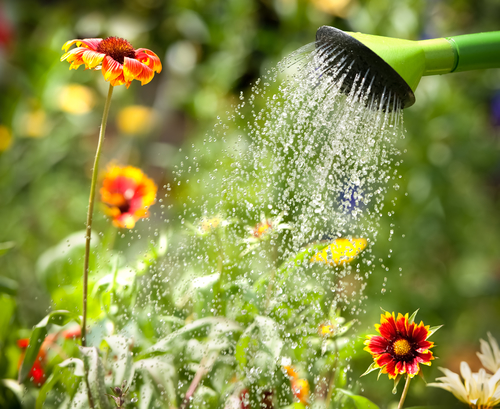
Even though insufficient water can be harmful to trees, plants or flowers an excessive supply of water can practically have the same effect. So it would be safe to say that not only do gardens need a consistent supply of water to stay well maintained but they need accurately, proportioned, amounts as well.
It may seem like somewhat of a challenge to actually estimate what constitutes the the correct proportion of water that should be supplied to a garden. Even though there is not really a standard way to gauge this there are some methods gardeners can apply to make sure plants always have the water they need.
Mulching is a very effective gardening method that helps gardeners to reduce the excessive watering of gardens. This method also helps to improve water retention and soil structure so that plants don’t constantly need to be watered.
Test Soil Regularly To Eliminate Unnecessary Watering Of Gardens
Disproportionately watering gardens tends to not only be a wasteful practice but it also causes gardeners to work more than necessary. Therefore gardeners should make it a practice to conduct regular tests on soil to determine whether or not plants need an immediate supply of water.
The best way to do this is to take a spade and push it deep into the soil. Once you pull the spade out check to see if it’s damp or dry which should give you an idea of if it’s time to water or not.
Remember though if you have clay soil it may feel damp whether it’s irrigated or not and sandy soil can feel dry even if it’s wet. So in cases like these gardeners should watch plants for when they start to show signs of water stress to determine when water should be supplied.
Some Mechanisms Can Provide An Adequate And Timely Water Supply To Gardens
Over time gardeners have taken advantage of the availability of certain tools that can help to effectively manage the water supply to their gardens. Some of these tools include automated irrigation and sprinkler systems which can not only minimize the time spent watering gardens but they can adequately supply water to plants at the required time.
Need Help With Irrigation Or Sprinkler Installation? Let DK Landscaping Manage The Job For You!
Are you are interested in installing an irrigation or sprinkler system in your garden but don’t know what to? Well not to worry here at DK Landscaping Inc. we specialize in all your landscaping and gardening services and we’d be happy to come in and complete the installation for you.
Striving to provide the highest, quality, services to all clients we offer extremely affordable rates and we work with clients to manage any type of gardening environment. So give us a call at: 707 280-3632 or visit our website:dklandscaping.com for more information.
Useful Gardening Tips That Promote Healthy Landscapes
As a gardener or landscaper maintaining beautiful surroundings and healthy plants is certainly an important priority and even though this may sometimes be challenging it is necessary if landscapes are to remain healthy and attractive. You want your friends and family to have fun in a garden that is full of life and energy and good maintenance is the key. There are several useful tips that gardeners can apply in effort to promote healthy landscapes and gardens.
Excellent Soil Quality is Vital in Maintaining Healthy Landscapes

Good soil quality is extremely important if plants and trees are to grow healthy and to their full potential. If you discover that your plants, trees or flowers are not thriving this may be due to poor soil quality however one approach that has proven to improve and maintain the quality of soil is the use of fertilizer.
Fertilizer can come in several forms and is an excellent way to enrich soil and promote plant growth. One of the most common forms of fertilizer used throughout gardens and landscapes is organic fertilizer.
Essentially organic fertilizer consist of naturally bio-degradable materials mainly in the form of animal manure but can also be other natural ingredients. It is great for gardens and crops as it not only restores soil quality but improves the long term health of soil promoting healthy landscapes overall..
Mulching Promotes Healthy Landscapes and Gardens
In looking for great ways to promote healthy landscapes and gardens another very useful tip gardeners can utilize is the application of mulch to garden beds and other landscape areas. Generally mulch is used to eliminate weeds, protect and stabilize plants and trees as well as to help soil retain moisture.
Mainly consisting of several, different, materials including chopped leaves, straw, grass clippings, wood chips,sawdust, shredded bark, gravel or stone mulch can be used in vegetable gardens, flower beds, plant pots, around trees, walkway areas, hedges and more.
Among many common gardening techniques the use of mulch has been found to be an easy, environmentally friendly way to promote healthy landscapes and gardens.
Proficient Irrigation Systems Help Promote Healthy Landscapes
In order for gardens or landscapes to remain lush and healthy having an adequate water supply is very important. So a great way to ensure that plants are properly supplied with water is by installing an irrigation system that provides a precise and timely supply of water to landscapes and gardens.
An irrigation system basically obtains water from a source and distributes it equally and uniformly to specific areas throughout gardens. Different kinds of irrigation used include high or micro flow irrigation, in-ground irrigation and automatic irrigation systems.
Over time irrigation methods have improved to better manage different types of gardening done so depending on what type of gardening you do installing the appropriate irrigation system is the best way to ensure gardens and landscapes receive the water they require.
Need Help With Your Landscaping?
Here at Dk Landscaping Inc. we aim to provide the highest quality landscaping and gardening services to clients. Our dedicated team works with clients to manage any type of gardening or landscape services you may need. Whether it be mulching, pruning, irrigation or even planting with affordable rates and great service we’d be happy to come in and assist. Contact us for more information.
Effective Garden Tips Part 1 – Use Mulch For A Healthy Garden
In an effort to keep gardens healthy and vibrant gardeners utilize a variety of tips and techniques that serve to nurture, protect and maintain their plants and vegetables. Among these techniques the use of mulch has been found to be one of the easiest and more common methods used to promote a healthy and consistent environment in gardens.
Generally mulching can be utilized in several different areas including vegetable gardens, flower beds, plant pots and walkway areas however it is mainly used to help in the elimination of annoying weeds and helps soil to retain moisture. Additionally it also helps to protect and stabilize plants, trees and crops.
Different Types Of Mulch
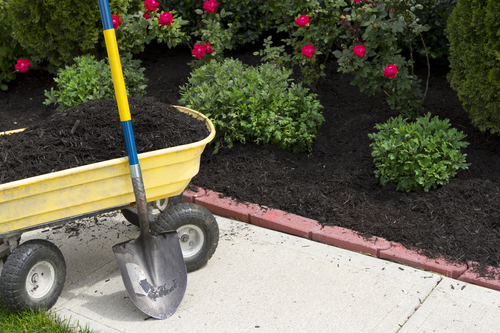
Basically there are two kinds of mulch that can be used in gardens and these are organic or inorganic mulch. Usually organic mulches consist of several different materials including chopped leaves, straw, grass clippings, wood chips, sawdust and shredded bark while inorganic mulches are mainly comprised of gravel, stones, black plastic, and geotextiles.
Nevertheless regardless of the type applied to a garden its use is mainly the same which is to discourage weed growth and improve soil quality however organic mulches gradually improve soil as they decompose while inorganic mulches don’t.
How To Mulch
Gardeners mulch gardens for a variety of reasons but depending on the reason there are certain tips that should be applied if this technique is to be done properly and is to work effectively.
Mulch To Be Rid Of Weeds
For instance if mulch is being used to eliminate weeds there are two important tips gardeners should remember if it is to be executed accurately. The first tip would be to place the it on soil that has already been weeded and the second would be to lay it down on soil thick enough to discourage new weeds from reappearing.
Normally the thickness of mulch should range from around 4 – 6 inches when applied however in areas where weed growth is not as common a layer of mulch measuring 2-3 inches should be enough to do the trick.
Mulching Reduces The Need To Water Gardens
As a great way to keep soil cool and help plants retain moisture in dry conditions gardeners can again apply mulch to their gardens. It also reduces the need to constantly water gardens and what’s more is that in cold conditions mulching also provides considerable protection to prevent the freezing and thawing of the soil as the gradual decomposition of materials only generate minimal heat.
Additional Tips To Consider
When using organic mulch it is important to remember that they carry a low nitrogen content therefore gardeners should first fertilize soil with a high-nitrogen product such as blood meal or fish meal to increase nitrogen levels in the soil before applying mulch.
Gardeners should also remember to keep mulch about an inch away from crowns and stems to prevent them from becoming choked or damaged and should also be careful not to allow wet mulch to rests against the stems of flowers and vegetables as it can cause them to rot.
So protect and maintain the ideal environment in gardens by considering mulching it will save you time and promote a healthy environment for your plants or vegetables.
Need Help In Your Garden?
If you don’t know what to do or need help mulching your garden don’t hesitate to give us a call at DK Landscaping Inc. at: (707) 217-6508 we’d be happy to come and give you a hand. You can also check out our website: dklandscaping.com to have a look at the services we offer.





